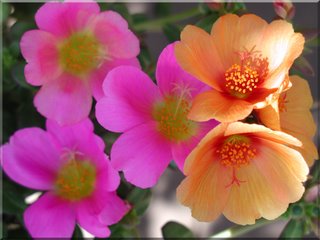More on moss rose (portulaca)



I was in the doctor's waiting room when I came across a magazine article on moss rose that I previously wrote about. Apparently people use it for medicinal and food purposes. The leaves were purportedly good for teeth clenching, muscle spasms and supposedly is very nutritious - being taken aboard ships to prevent scurvy.
So being culinaryly adventurous I pulled a leaf, washed it and popped it in my mouth. The taste was not very appealing, rather sour and the leaf itself was mucilagenous and the skin was quite tough. Similar to purslane which I tried once more than 20 years ago. I could see it being used sparingly in a wild salad but it's not to my taste.
Later I looked up portulaca in my botanical book and of course the moss rose tasted like purslane for they are both portulacas (head slap). The variety we have even has the rounded leaf of purslane rather than the skinny longer leaves of most desert rose.
I took a picture of strange looking clouds at dusk. The clouds were like spread out fingers on a giant hand seemingly emanating from a point. How can the winds be blowing in so many directions from a point?






2 Comments:
Many Desert Rose (Adenium Obesium) plants sold in this country are grown on an oleander rootstock. Oleander, of course, is extremely toxic. I would be very cautious about eating anything from a Desert Rose plant.
You're right about eating desert rose. I got it confused with moss rose and have corrected the article. Thanks for bringing it to my attention.
I was not aware that Adenium could be grown on oleander rootstock. Aren't they two different species?
Post a Comment
Subscribe to Post Comments [Atom]
<< Home